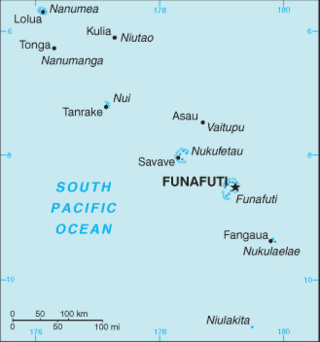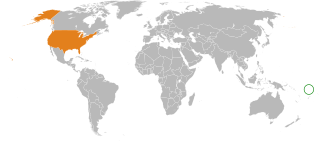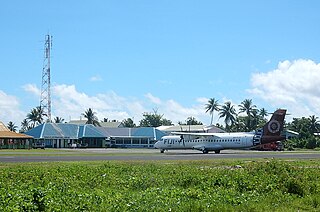Related Research Articles

Tuvalu, formerly known as the Ellice Islands, is an island country in the Polynesian subregion of Oceania in the Pacific Ocean. Its islands are situated about midway between Hawaii and Australia. They lie east-northeast of the Santa Cruz Islands, northeast of Vanuatu, southeast of Nauru, south of Kiribati, west of Tokelau, northwest of Samoa and Wallis and Futuna, and north of Fiji. Tuvalu is composed of three reef islands and six atolls. They are spread out between the latitude of 5° and 10° south and between the longitude of 176° and 180°. They lie west of the International Date Line. Tuvalu has a population of 11,204. The total land area of the islands of Tuvalu is 26 square kilometres (10 sq mi).

The Western Pacific nation of Tuvalu, formerly known as the Ellice Islands, is situated 4,000 kilometers (2,500 mi) northeast of Australia and is approximately halfway between Hawaii and Australia. It lies east-northeast of the Santa Cruz Islands, southeast of Nauru, south of Kiribati, west of Tokelau, northwest of Samoa and Wallis and Futuna and north of Fiji. It is a very small island country of 26 km2 (10 sq mi). Due to the spread out islands it has the 38th largest Exclusive Economic Zone of 749,790 km2 (289,500 sq mi).

The first inhabitants of Tuvalu were Polynesians, so the origins of the people of Tuvalu can be traced to the spread of humans out of Southeast Asia, from Taiwan, via Melanesia and across the Pacific islands of Polynesia.

Tuvalu is a Polynesian island nation located in the Pacific Ocean, midway between Hawaii and Australia, with a population of 11,192 per the 2017 census. The economy of Tuvalu is constrained by its remoteness and lack of economies of scale. Government revenues largely come from fishing licences ; direct grants from international donors ; and income from the Tuvalu Trust Fund. The lease of its highly fortuitous .tv Top Level Domain (TLD) also contributes revenue. The sale of stamps since the independence of Tuvalu in 1976 has been an important source of revenue for the country and government. However, such revenue has significantly declined in recent years. Tuvalu has hardly any tourism. It has no tour guides, tour operators or organised activities and no cruise ships visit.
From 1916 to 1975, Tuvalu was part of the Gilbert and Ellice Islands colony of the United Kingdom. A referendum was held in 1974 to determine whether the Gilbert Islands and Ellice Islands should each have their own administration. As a consequence of the referendum, the separate British colonies of Kiribati and Tuvalu were formed. Tuvalu became fully independent as a sovereign state within the Commonwealth on 1 October 1978. On 5 September 2000, Tuvalu became the 189th member of the United Nations.

Nanumea is the northwesternmost atoll in the Polynesian nation of Tuvalu, a group of nine coral atolls and islands spread over about 400 miles (640 km) of the Pacific Ocean just south of the equator and west of the International Date Line. Nanumea is 4 km2 (1.5 sq mi) with a population of 512 people.

Tuvalu – United States relations are bilateral relations between Tuvalu and the United States.

The following outline is provided as an overview of and topical guide to Tuvalu:

Approximately 86 percent of the population belong to the EKT, which has historical ties to the Congregational Christian Church and other churches in Samoa; 3 percent belong to the Seventh-day Adventist Church; and 3 percent to the Brethren Church. There are small numbers of Catholics, Muslims, Baha’is, Baptists, Jehovah’s Witnesses, members of the Assemblies of God, and members of The Church of Jesus Christ of Latter-day Saints.

Funafuti is the capital of the island nation of Tuvalu. It has a population of 6,320 people, and so it has more people than the rest of Tuvalu combined, with approximately 60% of the population. It consists of a narrow sweep of land between 20 and 400 metres wide, encircling a large lagoon 18 km long and 14 km wide. The average depth of the Funafuti lagoon is about 20 fathoms. With a surface area of 275 square kilometres (106.2 sq mi), it is by far the largest lagoon in Tuvalu. The land area of the 33 islets around the atoll of Funafuti totals 2.4 square kilometres (0.9 sq mi); taken together, they constitute less than one percent of the total area of the atoll. Cargo ships can enter Funafuti's lagoon and dock at the port facilities on Fongafale.
Renewable energy in Tuvalu is a growing sector of the country's energy supply. Tuvalu has committed to sourcing 100% of its electricity from renewable energy. This is considered possible because of the small size of the population of Tuvalu and its abundant solar energy resources due to its tropical location. It is somewhat complicated because Tuvalu consists of nine inhabited islands. The Tuvalu National Energy Policy (TNEP) was formulated in 2009, and the Energy Strategic Action Plan defines and directs current and future energy developments so that Tuvalu can achieve the ambitious target of 100% renewable energy for power generation by 2020. The program is expected to cost 20 million US dollars and is supported by the e8, a group of 10 electric companies from G8 countries. The Government of Tuvalu worked with the e8 group to develop the Tuvalu Solar Power Project, which is a 40 kW grid-connected solar system that is intended to provide about 5% of Funafuti’s peak demand, and 3% of the Tuvalu Electricity Corporation's annual household consumption.

Climate change is particularly threatening for the long-term habitability of the island country of Tuvalu, which has a land area of only 26 square kilometres (10 sq mi) and an average elevation of less than 2 metres (6.6 ft) above sea level, with the highest point of Niulakita being about 4.6 metres (15 ft) above sea level. Potential threats to the country due to climate change include rising sea levels, increasingly severe tropical cyclones, high temperatures, and drought.
Tuvalu is a small island nation in the South Pacific, located North of Fiji and North West of Samoa. The population at the 2012 census was 10,837. Tuvalu has a written constitution which includes a statement of rights influenced by the United Nations Universal Declaration of Human Rights and the European Convention on Human Rights. While most human rights in Tuvalu are respected, areas of concern include women’s rights and freedom of belief, as well as diminishing access to human rights in the face of global warming. The latter has played a major role in the implementation of human rights actions in Tuvalu given its geographical vulnerability and scarce resources.

The 2011 Tuvalu drought was a period of severe drought afflicting Tuvalu, a South Pacific island country of approximately 10,500 people, in the latter half of 2011. A state of emergency was declared on September 28, 2011; with rationing of available fresh-water. The La Niña event that caused the drought ended in April–May 2012. By August 2012 the El Niño-Southern Oscillation (ENSO) Conditions indicated that the tropical Pacific Ocean was on the brink of an El Niño event.
The Funafuti Conservation Area is a marine conservation area covering 33 square kilometers of reef, lagoon and motu (islets) on the western side of Funafuti atoll in Tuvalu. The marine environment of the conservation area includes reef, lagoon, channel and ocean; and are home to many species of fish, corals, algae and invertebrates. The islets are nesting sites for the green sea turtle and Fualopa hosts a breeding colony of black noddy.
Princess Margaret Hospital (PMH) on Funafuti atoll in Tuvalu is the only hospital in the country, and the primary provider of medical services for all the islands of Tuvalu. The hospital is located about 1.3 kilometres north from the centre of Funafuti on Fongafale islet.

Women in Tuvalu continue to maintain a traditional Polynesian culture within a predominantly Christian society. Tuvaluan cultural identity is sustained through an individual's connection to their home island. In the traditional community system in Tuvalu, each family has its own task, or salanga, to perform for the community. The skills of a family are passed on from parents to children. The women of Tuvalu participate in the traditional music of Tuvalu and in the creation of the art of Tuvalu including using cowrie and other shells in traditional handicrafts. There are opportunities of further education and paid employment with non-government organisations (NGOs) and government enterprises, education and health agencies being the primary opportunities for Tuvaluan women.

Crime in Tuvalu is not a significant social problem due to small population, geographic isolation, and low development.
As in much of Oceania, obesity is a major health issue in Tuvalu with 65% of men and 71% of women being overweight. In 2012 the birth rate on the islands was estimated at 23 per 1,000 people and life expectancy was 65.
Tuvalu National Council for Women (TNCW) is a Tuvaluan national council, which is the umbrella organisation for non-governmental women's rights groups in the country. The TNCW aims to enable gender equity in Tuvalu, through educational campaigns and through resourcing women to be informed about their economic, legal and social rights.
References
Citations
- 1 2 "Tuvalu's disability study from the perspective of a field worker - Pacific Women Shaping Pacific Development". Pacific Women Shaping Pacific Development. 3 December 2017. Retrieved 2017-12-20.
- 1 2 ESCAP 2012, p. 96.
- ↑ "Tuvalu" . Mental Health Atlas: 476–477. 2005 – via EBSCOhost.
- 1 2 3 4 5 United States Department of State (2016). Tuvalu 2016 Human Rights Report (PDF) (Report). p. 10. Retrieved 20 December 2017.
- ↑ ESCAP 2012, p. 97.
- ↑ "Disability in the Pacific". Pacific Disability Forum. Retrieved 2017-12-20.
- 1 2 3 PDF & APIDS 2012, p. 2-3.
- ↑ PDF & APIDS 2012, p. 11.
- 1 2 Government of Tuvalu 2006, p. 46.
- 1 2 Price, Penny (1996). "Developing Services in the South Pacific". Beyond Basic Care: Special Education and Community Rehabilitation in Low Income Countries. North York, Ontario: Captus Press. pp. 91–92. ISBN 9780921801955.
- ↑ "Fusing tradition and technology to protect communities in Tuvalu". International Federation of Red Cross and Red Crescent Societies. Retrieved 2017-12-20.
Sources
- ESCAP (2012). Disability at a Glance 2012: Strengthening the Evidence Base in Asia and the Pacific (PDF). United Nations.
- Government of Tuvalu (2006). Tuvalu: A Situation Analysis of Children, Women and Youth. Chris McMurray. Suva, Fiji: UNICEF.
- PDF; APIDS (March 2012). "Report on Tuvalu Component of Research". Capacity Development for Effective and Efficient Disabled Persons Organisations in Pacific Island Countries.